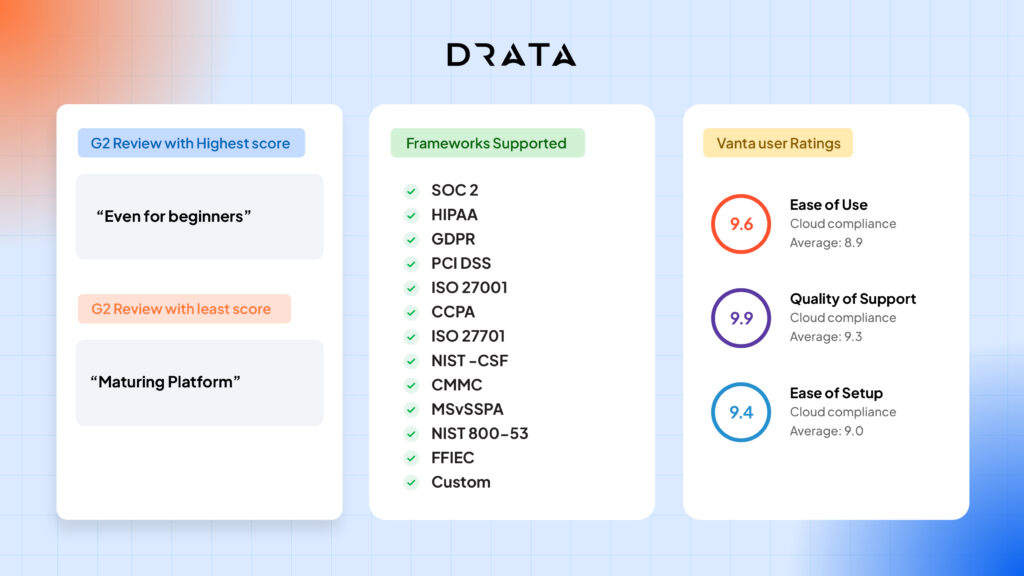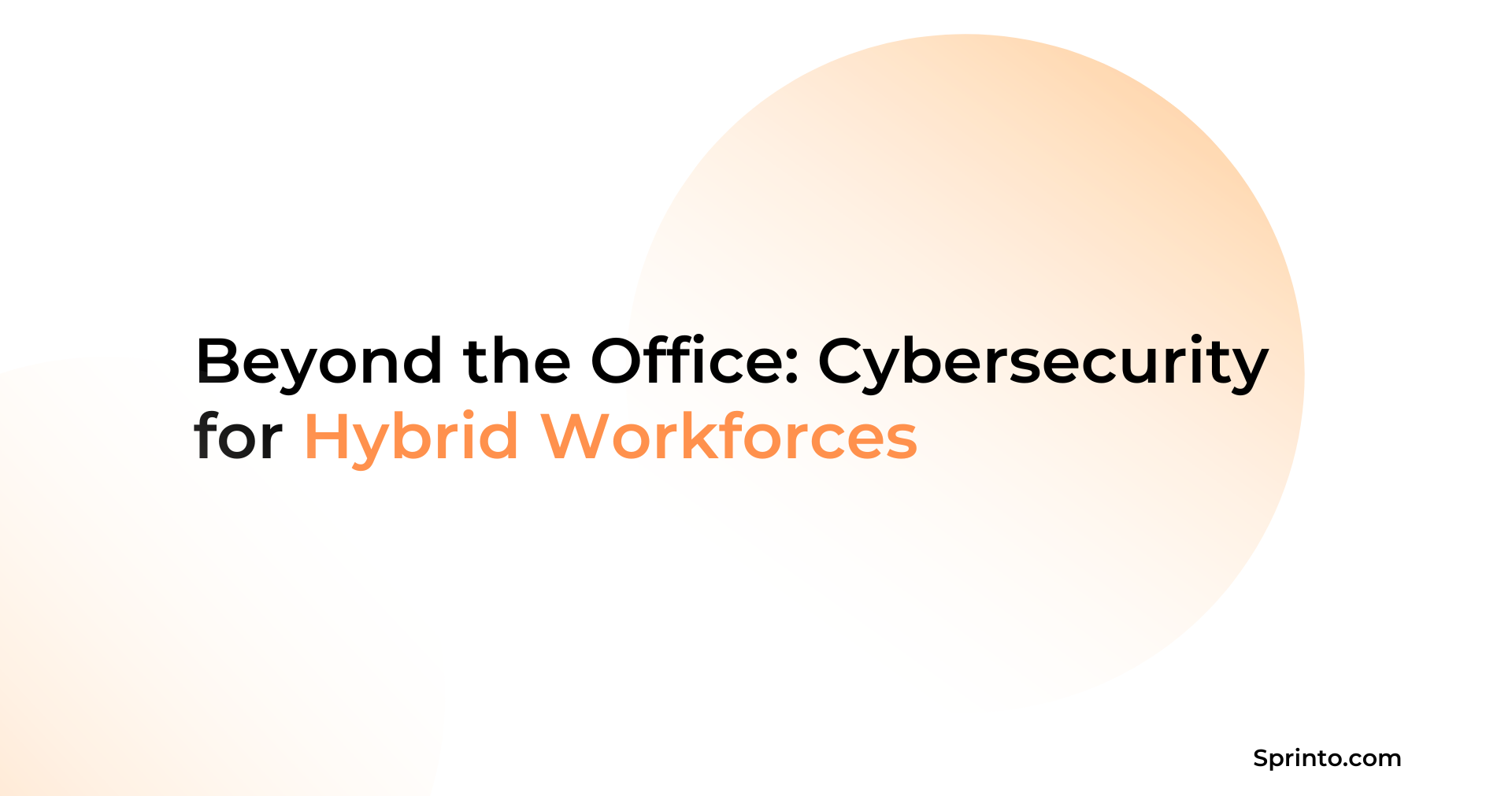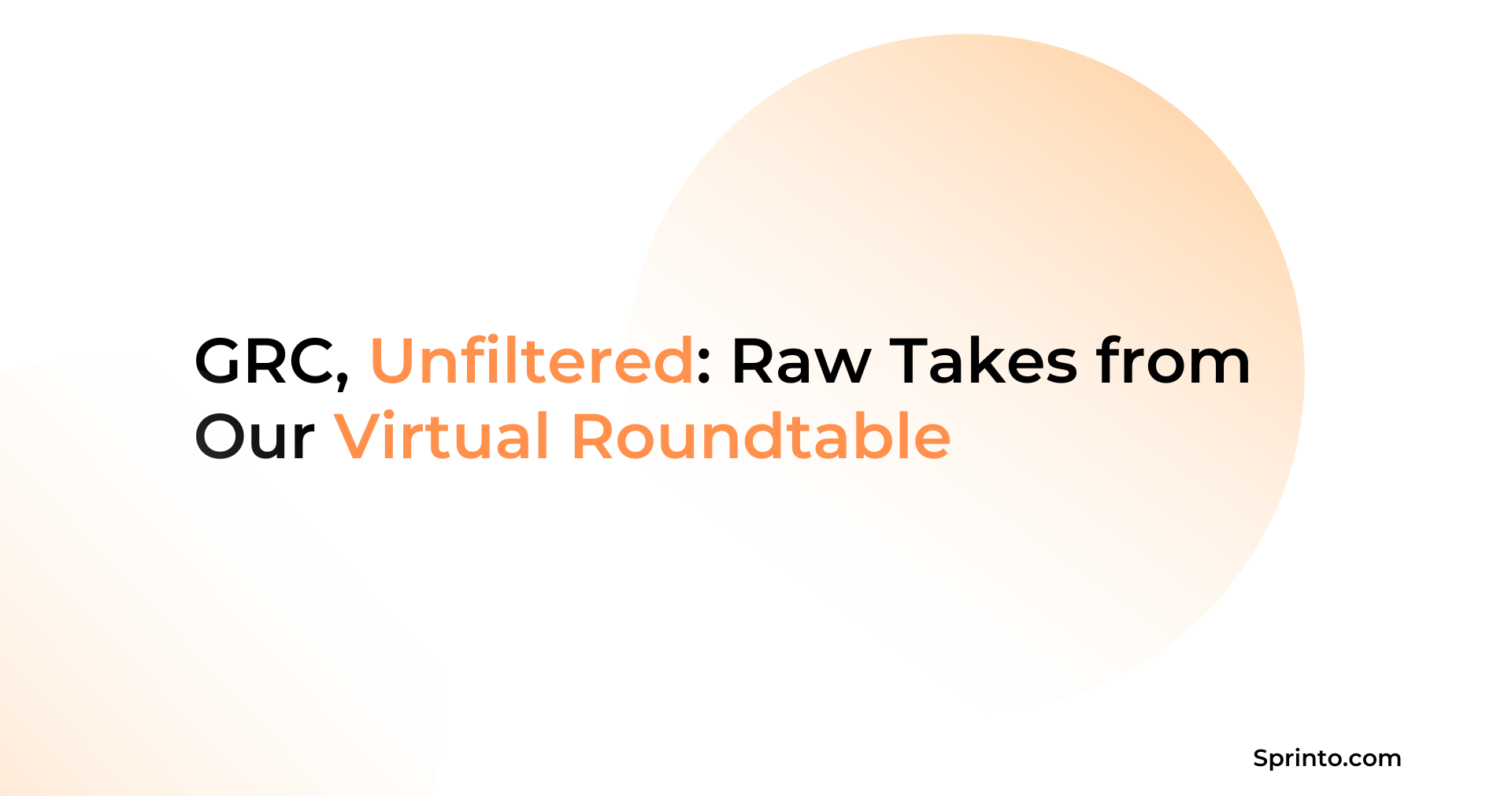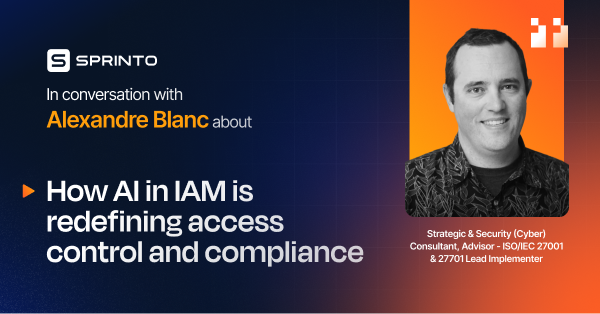Top 6 Vanta Competitors & Alternatives – Detailed Comparison
Anwita
Jan 20, 2025
If you are looking for a compliance and security automation solution, in all probability, you considered Vanta. Being the first to enter this space, they boast an impressive list of customers. But bigger doesn’t necessarily mean better – with more competitors offering the same and often better features, your search for the best solution should not end at Vanta.
This article aims to walk you through the Vanta alternatives – the pros, the cons, and the key features. We have compiled data from genuine user reviews to help you make an informed decision by the end!
What is Vanta?
Vanta is a compliance management platform for SaaS businesses. The solution helps users scale compliance frameworks like SOC 2, ISO 27001, HIPAA, and more.
It automates compliance-related tasks required to reach audit readiness by monitoring the security posture, surfacing risks across the infrastructure, collecting evidence, and managing vulnerabilities.
Vanta in a nutshell:

What is Vanta’s pricing model?
Vanta’s pricing module starts from $7,500 and can be customized depending on the complexity of your requirements. You can request a custom quote for more details.
In general, the pricing structure for security compliance tools usually depend on multiple factors. These include:
- Number of employees
- Location of operation
- Number of frameworks selected
- Existing processes and tools
- Contract term duration
Why look for Vanta alternatives?
Despite being the earliest driver in the compliance market, Vanta’s solution does not square up to some of its core competitors. It lags behind in terms of number of frameworks supported, level of customization, and lacks depth in monitoring among many otters.
All in all, customers found some minor drawbacks with the product. Here’s what we gathered from G2 reviews:
- Does not fully support custom application integration tasks like evidence collection, making it a manual process
- Offers generic best practices and recommendations that fail to cater to unique business needs
- The solution could be more cost-effective – new feature releases are chargeable and stretch the budget
- Over indexed for simplicity, the platform lacks the level of granularity to drive smoother audits
- The platform lacks modularity, rendering it ineffective to transfer tasks for compliance programs like SOC 2
- Some users found the learning curve steep and overwhelming without technical assistance
6 Best Vanta Alternatives
Are you looking for a similar product to Vanta? Here are the top Vanta competitors:
1. Sprinto
Sprinto is designed to facilitate end-to-end compliance automation, tracking, auditing, and risk appetite for cloud-hosted SaaS businesses.
It maps common control requirements of popular frameworks to enable real-time monitoring, consolidate risks, and run fully automated checks from a centralized dashboard.
The solution empowers businesses to scale their compliance and audit readiness efforts without compromising engineering bandwidth.
All features, strengths, and capabilities considered, Sprinto is one of the best alternatives to Vanta.
Pros
Pre-built, auditor-friendly compliance programs engineered keeping auditor-friendliness in mind. Offers a comprehensive auditor customizable dashboard to help users collect, edit, and view evidence.

Triggers notification and flags non-compliant activities to escalate issues to concerned individual with detailed insight into nature of risk, recommended actions, level of criticality, area of concern, and more
Giift streamlined security ops across 14 entities following ISO 27001 implementation with Sprinto. Learn more about our process.

Users can set up role-based access to segregate tasks, ensure data minimization, and prevent unintended data tampering.
The risk prioritization and profiling capabilities go beyond just raising tickets by prompting corrective actions while generating audit proof
Deep visibility into cloud assets across service providers enables IT teams to identify and triage assets

Business specific guidelines, policies, and recommendations assist users to scale faster and launch quickly
HubEngage transformed compliance for SOC2, ISO 27001, GDPR, and HIPAA.
BYOF (Bring Your Own Framework) and magic mapping automatically checks for your custom framework. Supports entry-level preventive and defensive security controls

AI-based recommendations help to mark some checks as exceptions. The snooze functionality allows users to assign a time limit to manage exception checks
In-build vendor management allows users to mark the type of data exposed to a vendor and suggests the risk level (high, medium, low) based on data exposure
Offers granular security program that supports and drives smoother audits and a sweeping compliance program
Deeper integration like our code repository integrations for GitHub checks if codes are peer reviewed and checks for branch level changes
Cons:
- The product is continuously undergoing updates. With new features added frequently, some existing users may not be fully familiar with small UI changes at first
- Designed specifically for cloud-hosted companies, the tool is not highly recommended for on-premises organizations
- Users accustomed to complex policies complained that some policies may be oversimplified and not suffice for the use case
2. Drata
Drata automates security and compliance to help businesses meet regulatory framework requirements for SOC 2, HIPAA, GDPR, ISO, and more.
It integrates with popular cloud services to streamline end-to-end compliance workflows like evidence collection, control monitoring, data governance, and policy enforcement.

Pros
- Monitors the IT environment and triggers alerts based on harmful activities and user behavior
- Enables users to create, edit, and track access privileges. Ensures user access management, data lineage, and data encryption
- Users can create and streamline workflows related to ticketing and services. IT teams can set security and data governance related policies
- The centralized dashboard offers insightful data and enables users to implement custom policies for risk and asset management
Cons
- Document and policy management features are clunky and prevent a seamless overall experience
- Does not allow users to edit evidence once uploaded, creating duplicate evidence in the system
- Lack of transparency on the pricing model during the sales stage can create post purchase surprises. For example, users charged for add-on features faced budgeting issues.
- Lacks the capability to facilitate tiered escalation for critical and failing checks.
3. Secureframe
Secureframe helps businesses scale their SOC 2, ISO 27001, PCI DSS, HIPAA, GDPR, CCPA and NIST compliance processes. Its key capabilities include scanning the cloud infrastructure for vulnerabilities, vendor risk assessment, employee security training, and automated evidence collection.
Pros
- Prevents data loss by securely storing it on-premise or adjacent cloud base. Analyses suspicious data to provide insights into security protocols and authentication
- Tracks, triages, and assigns risks to owners from a single dashboard to improve visibility and accountability
- The report generator collects, tracks, and consolidates data such as passing and failing controls to ensure compliance
- Continuously monitors compliance status in real-time to offer actionable insights into security and compliance fails.
Cons
- Compliance assessments for complex systems like Google Cloud, Jira, and GitHub require manual intervention to meet the required configuration
- Does not offer granular, actionable, deep insight into failing tests. Resolution steps clack clarity
- Some users found that integration with common cloud services is not smooth and often buggy
4. Hyperproof
Hyperproof, a risk and compliance management platform, helps security teams stay on top of frameworks like SOC 2, ISO, and NIST CSF.
The solution integrates with cloud services to operationalize risk management, automate workflows, collect evidence, and prepare for audits. Users can map controls across frameworks and collaborate with stakeholders from a centralized dashboard.

Pros
- Offers a bundled solution containing training and learning materials for new and existing employees.
- The intuitive Ui enables users to configure the platform without guidance from the technical support team.
- Identifies and triages risks into human, technical, and external categories or based on framework specific requirements.
Cons
- Despite being intuitive, the UI can be slow and buggy according to some users, limiting the capabilities to perform certain functions with ease.
- The overall solution needs to be more comprehensive and granular to allow users to perform custom actions.
- Does not allow auditors to upload, download, or change request status in specific cases.
- Limited automation capabilities for the reporting function require manual intervention.
5. Thoropass
Thoropass (previously known as Laika) integrates with existing processes to facilitate continuous monitoring, pass audits easily, and comply with various infosec and privacy frameworks. It offers a seamless auditing experience, automates compliance-related tasks from a single dashboard, and streamlines due diligence processes.

Pros
- IT teams can set custom policies for data governance, role based access, and manage access privileges.
- Monitors the IT environment and generates reports based on violations or malicious behavior
- Helps to pass and manage SOC 2 compliance with little effort.
Cons
- Does not offer a vast range of options for integration options. The integration system is clunky and often buggy.
- The pre-built templates are suitable for large organizations. Users from smaller businesses reported it to be overkill.
- The UI is not clean and lacks the required level of granularity
6. Strike Graph
Strike Graph offers compliance operation and certification solutions to help organizations complete their audit processes faster. Users can build an effective security program to meet compliance requirements, operationalize workflows using automated dashboards, and track compliance progress for multiple frameworks using a single platform.
Pros
- Easy to use and intuitive user interface speeds up the onboarding process. The simplicity and well thought out navigation system facilitates a seamless experience.
- Organizes critical data in an easy to understand format that enables teams to quickly view outstanding tasks and collaborate with functions
- Users found the evidence uploading system particularly useful as the platform offers guidance to link evidence to the right control to satisfy a certification requirement
- Users appreciated the customer success team for their guidance and promptness in resolving issues
Cons
- Lacks integration for important tools like Jira, GitHub, and Atlassian
- The platform does not allow users to attack more than one piece of evidence to a control
- The evidence collection process is not fully automated. Customer reported the need for manual intervention for capturing screenshots
We add the sass in SaaS
We hope this helped you finalize your compliance partner. We know the skepticism that comes with choosing and onboarding a new vendor. Buyer remorse is real, and we don’t want you to regret it afterward.
So if you are not sure, let our compliance experts help you. Let us help you understand how you can leverage Sprinto to meet your needs. Or how businesses similar to yours used our tool to get excellent results. We go above and beyond to ensure your success by holding your hand throughout the process from start to finish. Get started today to make your life easier!
FAQs
What is the pricing of Vanta?
The pricing of Vanta’s contract is between $7,500 to $100,000 and boils down to a number of factors like employee strength, selected compliance frameworks, existing security posture, and your contract term.
What are the best alternatives to Vanta?
The best alternative is ideally the one that caters best to your specific business needs. A demo usually helps to come to a better decision. However, based on user feedback and functionalities, the best recommended alternatives are Sprinto, Drata, and Secureframe.


Use Sprinto to centralize security compliance management – so nothing
gets in the way of your moving up and winning big.




















